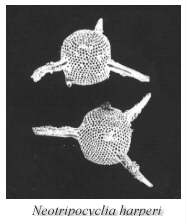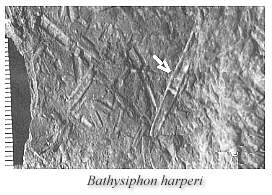Knowing His Field From the Ground Up

Structural geologist Gregory Harper does more than wait by his lab table.
by Vinny Reda
Ordinarily, a structural and regional geologist might find a fossil under the microscope. But
Gregory Harper, being unusually well-rounded and well-traveled, has also found many beneath
his feet. And since two were never found before, they now bear his name.
Harper is not a paleontologist, the type of scientist that studies fossils for a living. He is one of the three
workers in the structural geology and tectonics group in the University's Department of Earth and Atmospheric Sciences. But he does research overlapping a wide range of geologic subdisciplines. For the
last three years, for instance, he traveled to Italy's northern Apennines to study and document
faulting that occurred when the ocean crust was formed at a mid-ocean ridge some 160 million
years ago.
He also does a variety of lab work including mineral identification and microstructural analysis
using optical microscopes, chemical analyses of individual mineral grains using the electron
microprobe at RPI, geochemical analyses of whole-rock samples, geochronology (determining
a rock's age in millions of years using radioactive isotopes), and geologic synthesis resulting in
models of the interaction of plates during the Jurassic period (200 to 140 million years ago).
Since fossils are often used to determine the age of the rocks he studies, they have great
scientific merit for him. "Fossils are the skeletal remains of animals and plants that lived
in the past and became incorporated into sediment that was buried and turned into a sedimentary
rock," said Harper. "To most people, fossils are a curiosity found in museums, with the
greatest interest in animals such as dinosaurs. But to geologists, fossils have great practical
value."
Harper's interest in these remnants of time, however, goes much deeper. As an
undergraduate field assistant, he found and helped excavate an important mammal fossil
locality in Miocene age rocks of northwestern Nebraska. Professor Robert Hunt of the University
of Nebraska subsequently published a landmark paper on the paleoecology of this locality during
the Miocene, and in this publication he named the new fossil locality "Harper Quarry."
It consists of sediments laid down by an ancient stream and contains many disarticulated bones
of several types of animals, including rhinoceros and a variety of extinct species of herbivores
and carnivores.
Harper has found a number of rare fossil localities during his field work in California and Oregon,
but they rarely contain "new" species, that is, species never before found and named.
"In much of California there isn't very good fossil age-control, so whenever you find one out
there it's extremely important. In Italy all the fossil work has been done, so I must admit it's more fun
for me in the northwest, being very likely the first geologist ever to go down a certain creek or road.
So I always keep an eye out for fossils. I know it's either me, or no one."
When he finds fossils, he sends the specimens to a paleontologist who specializes in their type. The
paleontologist then identifies the fossils which help determine the age of the rocks in which they
were found or, if they are a new species, describe and name them in a scientific article for journals
such as the Journal of Paleontology or Micropaleontology.
 Harper first struck geologic gold in northern California, where he mapped and described a critical
rock unit containing thousands of radiolarian fossils. This led to a fossil species of radiolarian being
named after him in 1993 by Emile Pessagno of the University of Texas at Dallas: Neotripocyclia
harperi.
Harper first struck geologic gold in northern California, where he mapped and described a critical
rock unit containing thousands of radiolarian fossils. This led to a fossil species of radiolarian being
named after him in 1993 by Emile Pessagno of the University of Texas at Dallas: Neotripocyclia
harperi.
"Radiolaria are microscopic one-celled amoebae-like organisms that secrete a siliceous shell,"
said Harper. "They mostly live in the upper few meters of the ocean, but when they die the shells
settle to the ocean bottom where they accumulate as sediment on top of the oceanic crust. Millions
of years later, when large pieces - or 'plates' - of the earth's crust collide, the oceanic crust and overlying
sediment can be thrust onto the continents where we see them today as ophiolites."
The naming of the new radiolarian species after Harper was in honor of his work in locating the fossil localities and
for providing their regional geologic background. He and two colleagues then radiometrically dated
the volcanic rocks of the ophiolite directly beneath the layers containing the fossils, thus providing
one of the best absolute age constraints in the world for the Jurassic period.
"What happens is very cooperative, really," said Harper, detailing how the age of rocks is
determined in two ways. Fossils in sedimentary rocks clearly change with time, and in the 1800s
geologists developed a Geologic Time Scale with units of time defined by the distinct changes of
life on earth as recorded by the fossils ("Jurassic" is one of these units). This allowed for
rocks and geologic events to be dated in relative terms, though not in numerical terms (number of
years).
"Numerical age controls became available early in the 20th Century with dating of certain minerals by radioactive
decay," said Harper, "but relatively old fossil-bearing rocks can rarely be dated directly.
So it is important to find localities where fossil-bearing sedimentary rocks are interlayered with lava
flows. Such critical localities provide the numerical ages needed to put numbers in years on the
Geologic Time Scale."
Harper and colleagues then began their age-dating based on measurements of radioactive decay.
"One of the most important contributions came from new lab techniques allowing very
precise dating," he said. "We were able to obtain ages of 160-million-year-old
rocks with as little as 1 million years uncertainty, where before uncertainties of 5 million years
were typical.
Curiously, the ophiolites in northern Italy, now the subject of study by
Harper, are essentially the same age as the ones he has worked on in NW California,
and they are overlain by sedimentary rocks containing many of the same species of radiolaria.
Harper and a colleague at Cal Tech are presently determining precise ages for the Italian
ophiolites, which will help further constrain the absolute age for this part of the
Jurassic period.
"Structural geology looks at the 3-D geometry of rock deformation
whereas tectonics places this deformation within a global framework of plate
tectonics, the unifying theory in the earth sciences," he said. "Plate
tectonics refers to the observation that the earth's crust is broken into about a
dozen large plates and many small plates that move slowly - about an inch
per year - with respect to each other. This results in earthquakes, deformation
of rock, and often volcanism near and along the plate boundaries."
Among Harper's research has been:
(1) the regional geology and tectonics of
Jurassic rock complexes in NW California and SW Oregon,
(2) study of ancient oceanic crust now exposed as rock complexes on land (ophiolites), with field
research focused in NW California, Wyoming, and northern Italy, and
(3) the structure of modern oceanic crust (participation in the Ocean Drilling Program).
Harper's field work involves mapping of rock units in ophiolites and in their
overlying deep-water sedimentary rocks, taking measurements of faults and
other structural features, and sampling of rock specimens for lab work.
 It was while on a field trip through the forests of southern Oregon in 1994
(accompanied by his dog Berlioz, who helped shoo away bears),
that Harper made his second find. Within a single sandstone slab
near the Rogue River, he uncovered the fossil that is now Bathysiphon harperi,
in his honor.
It was while on a field trip through the forests of southern Oregon in 1994
(accompanied by his dog Berlioz, who helped shoo away bears),
that Harper made his second find. Within a single sandstone slab
near the Rogue River, he uncovered the fossil that is now Bathysiphon harperi,
in his honor.
The new fossil locality found by Harper
contained a yet-unrecognized species of Bathysiphon, the sample
of which is now housed in the collections of the Smithsonian.
Only a handful of Bathysiphon localities have ever been found
on earth, but Harper has since located a second approximately
40 miles farther south, but it contains no new species.
"Bathysiphon fossils consist of the skeleton of a one-celled amoebae-like animal
called foraminifera," he said. The genus Bathysiphon is very
unusual for a foraminifera because of its large size. Nearly all
modern and fossil foraminifera are microscopic in size, but Bathysiphon
is several inches long with a shape similar to a swizzle stick
used with cocktail drinks.
"Bathysiphon apparently lived in
mud on the sea floor at great water depths (several miles). Fossils
in deep ocean sedimentary rocks are very rare because few organisms
live in the deep ocean where it is cold and totally dark and where
pressures are very high."
Equally rare, however, may be the
laboratory scientist making discoveries outside his own field
of research, effectively advancing the science from both ends.
"I guess I have to admit I have somewhat of a knack for coming
upon these specimens," said Harper. "It is one thing
that keeps research so interesting."
 Harper first struck geologic gold in northern California, where he mapped and described a critical
rock unit containing thousands of radiolarian fossils. This led to a fossil species of radiolarian being
named after him in 1993 by Emile Pessagno of the University of Texas at Dallas: Neotripocyclia
harperi.
Harper first struck geologic gold in northern California, where he mapped and described a critical
rock unit containing thousands of radiolarian fossils. This led to a fossil species of radiolarian being
named after him in 1993 by Emile Pessagno of the University of Texas at Dallas: Neotripocyclia
harperi.

 It was while on a field trip through the forests of southern Oregon in 1994
(accompanied by his dog Berlioz, who helped shoo away bears),
that Harper made his second find. Within a single sandstone slab
near the Rogue River, he uncovered the fossil that is now Bathysiphon harperi,
in his honor.
It was while on a field trip through the forests of southern Oregon in 1994
(accompanied by his dog Berlioz, who helped shoo away bears),
that Harper made his second find. Within a single sandstone slab
near the Rogue River, he uncovered the fossil that is now Bathysiphon harperi,
in his honor.